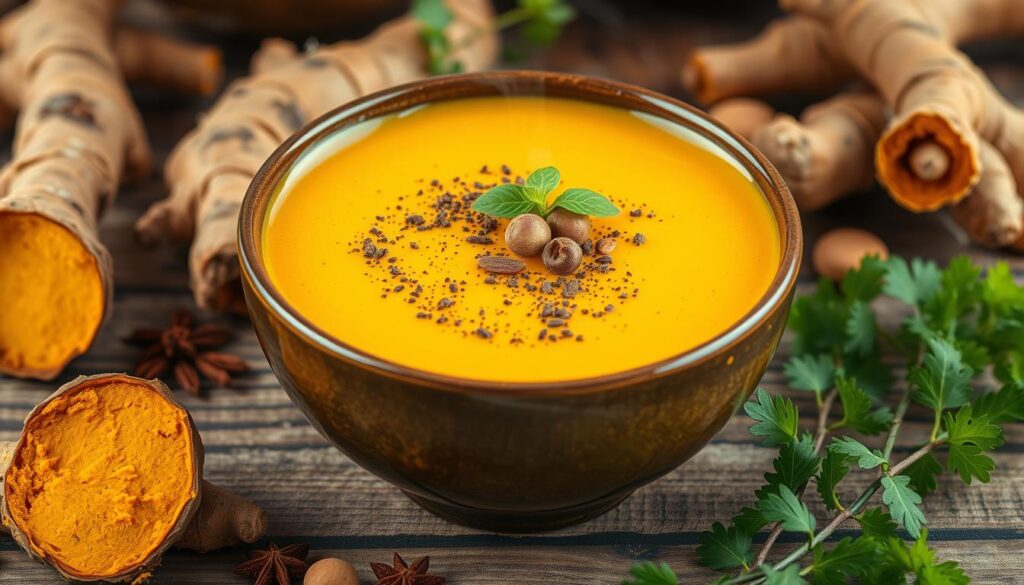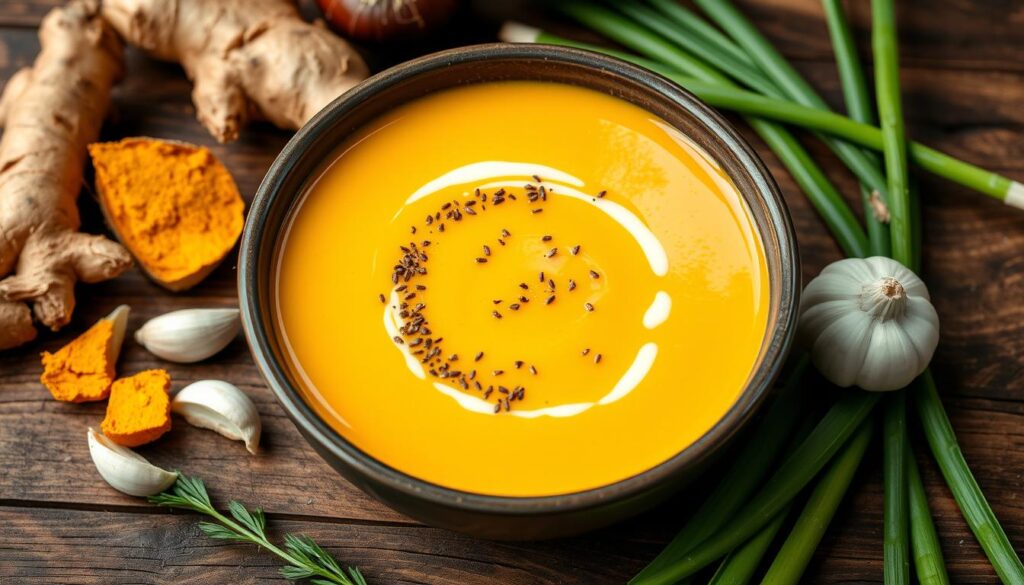Imagine a steaming bowl of savory, fragrant soup. It not only delights your taste buds but also boosts your immune system. Welcome to the world of turmeric anti-inflammatory soup, a culinary delight that fights inflammation naturally.
Turmeric, the vibrant yellow spice, is celebrated for its medicinal properties. Its active compound, curcumin, is known for its strong anti-inflammatory effects. By adding this versatile ingredient to a nourishing soup, you can support your body’s natural defenses and boost your immune system.
Key Takeaways
- Turmeric anti-inflammatory soup is a powerful way to boost your immune system and combat inflammation naturally.
- The active compound in turmeric, curcumin, is renowned for its potent anti-inflammatory properties.
- Incorporating turmeric into a nourishing soup can help support your body’s natural defenses and promote overall health.
- This recipe is a delicious and convenient way to harness the benefits of turmeric and other immune-boosting ingredients.
- Enjoy the warming, comforting flavors of this anti-inflammatory soup while reaping the rewards of its health-promoting effects.
Understanding the Power of Turmeric in Fighting Inflammation
Turmeric, a bright yellow spice, is known for its anti-inflammatory powers. At its core is curcumin, a compound studied by scientists worldwide.
The Science Behind Turmeric’s Anti-inflammatory Properties
Curcumin, turmeric’s key ingredient, fights inflammation well. It blocks enzymes and proteins that cause inflammation. This action helps reduce swelling and eases symptoms, making turmeric a natural remedy.
Curcumin: The Active Compound in Turmeric
Curcumin makes up a big part of turmeric, up to 3%. It has many health benefits, like fighting inflammation and protecting against cancer. Scientists are still learning about curcumin’s many uses.
Historical Use of Turmeric in Traditional Medicine
Turmeric has been used in medicine for thousands of years. It’s been a key part of Ayurveda and traditional Chinese medicine. These systems have used turmeric to treat many health issues, showing its lasting value.
| Compound | Primary Health Benefits |
|---|---|
| Curcumin | Anti-inflammatory, antioxidant, potential anti-cancer properties |
| Turmerones | Anti-inflammatory, antimicrobial, potential neuroprotective effects |
| Demethoxycurcumin | Anti-inflammatory, antioxidant, potential anti-cancer properties |
Health Benefits of Turmeric Anti-Inflammatory Soup
Adding turmeric soup to your meals can boost your health. It’s packed with anti-inflammatory goodness. This yellow soup helps your immune system, cuts down inflammation, and aids in digestive health.
Turmeric soup is great for your immune system. It has curcumin, a powerful compound. Curcumin fights off infections and keeps you healthy.
Drinking turmeric soup also lowers inflammation in your body. Chronic inflammation can lead to many health problems. This soup helps keep your body’s inflammation in check.
Also, turmeric is good for your digestive health. Curcumin soothes your digestive system. It can ease symptoms of IBS and improve gut health.
“Turmeric’s anti-inflammatory and antioxidant properties make it a powerful tool in supporting overall health and well-being.”
Looking to boost your immune system, reduce inflammation, or improve digestive health? Try a warm bowl of turmeric anti-inflammatory soup. It’s tasty and full of health benefits.
Essential Ingredients for Your Immune-Boosting Soup
To make a soup that boosts your immune system, you’ll need fresh turmeric, ground turmeric, black pepper, ginger, garlic, and coconut oil. Each ingredient is key to making your soup anti-inflammatory and immune-boosting.
Fresh vs. Ground Turmeric Options
Fresh and ground turmeric both have benefits. Fresh turmeric gives a stronger flavor and more curcuminoids, which are good for you. Ground turmeric is easier to use but less potent. Choose based on what you like and what’s available.
Supporting Ingredients That Enhance Absorption
Black pepper is crucial for making turmeric work better. It has piperine, which boosts curcumin absorption. Coconut oil also helps your body use turmeric’s benefits because of its healthy fats.
Additional Immune-Boosting Elements
Ginger and garlic add to your soup’s immune-boosting power. Ginger fights microbes and inflammation. Garlic strengthens your immune system and fights infections.
| Ingredient | Benefit |
|---|---|
| Fresh Turmeric | Potent anti-inflammatory and antioxidant properties |
| Ground Turmeric | Convenient and easy to incorporate into recipes |
| Black Pepper | Enhances the absorption of curcumin, the active compound in turmeric |
| Ginger | Possesses antimicrobial, anti-inflammatory, and antioxidant properties |
| Garlic | Supports the immune system and helps fight off infections |
| Coconut Oil | Healthy fats that further enhance the absorption of turmeric’s compounds |
Step-by-Step Recipe: Turmeric Anti-Inflammatory Soup
Try this delicious turmeric soup recipe to spice up your meals. It’s full of turmeric’s anti-inflammatory powers. This homemade anti-inflammatory soup is great for boosting your immune system and warming your heart.
To start, collect these ingredients:
- 1 tablespoon of coconut oil or olive oil
- 1 onion, diced
- 3 cloves of garlic, minced
- 2 tablespoons of freshly grated turmeric or 2 teaspoons of ground turmeric
- 1 teaspoon of ground cumin
- 1 teaspoon of ground coriander
- 4 cups of vegetable or chicken broth
- 1 can of diced tomatoes
- 1 cup of cooked chickpeas or lentils
- Salt and pepper to taste
- Optional toppings: chopped parsley, a squeeze of lemon, or a dollop of plain yogurt
Heat the coconut or olive oil in a big pot over medium heat. Add the diced onion and cook for 5-7 minutes until it’s soft. Then, add the minced garlic and cook for another minute until it smells good.
Now, add the turmeric, cumin, and coriander. Cook for 2-3 minutes, letting the spices smell great.
Next, add the broth, diced tomatoes, and chickpeas or lentils. Let it simmer for 15-20 minutes, so the flavors mix well.
Season with salt and pepper to taste. Serve the turmeric anti-inflammatory soup in bowls. You can add parsley, lemon, or yogurt on top, if you like.
Enjoy this healthy and easy immune-boosting meal. It will make you feel good and keep you healthy.

Tips for Maximum Nutritional Benefits
Enjoying your turmeric anti-inflammatory soup to the fullest means paying attention to storage and reheating. Knowing when to eat it can also boost its benefits.
Proper Storage and Reheating Methods
To keep your soup full of nutrients, follow these tips:
- Keep the soup in airtight containers in the fridge for up to 5 days.
- Reheat it on the stovetop instead of microwaving to protect turmeric’s compounds.
- Freeze it in portions for months of nutritional goodness.
Best Time to Consume for Optimal Results
For the best results, eat your turmeric soup at these times:
- Start your day with it to boost your immune system and fight inflammation.
- In the cold months, it helps fight off winter illnesses.
- After exercising, it helps with muscle recovery and eases soreness.
By following these tips, your homemade turmeric soup will be packed with nutrients. It will support your health and well-being.
Customizing Your Soup for Dietary Restrictions
Turmeric anti-inflammatory soup is a nourishing and versatile dish. It’s easy to adapt for various dietary needs. Whether you’re vegan, gluten-free, low-carb, or need allergen-free options, there are plenty of ways to customize this flavorful soup.
Vegan Turmeric Soup
For a vegan-friendly version, swap out the chicken or bone broth for a high-quality vegetable or vegan turmeric soup base. Use plant-based milk, like almond or coconut milk, instead of dairy. Adding cooked lentils, chickpeas, or tofu can boost the protein.
Gluten-Free Options
To make this soup gluten-free, use gluten-free broth and skip the traditional flour-based thickeners. Instead, use gluten-free options like arrowroot powder or xanthan gum to achieve the right consistency.
Low-Carb Variations
For a low-carb spin, reduce or eliminate starchy vegetables like potatoes. Focus on low-carb low-carb variations like cauliflower, zucchini, or radishes. Xylitol or erythritol can be used as a natural sweetener instead of honey or maple syrup.
Allergen-Free Alternatives
If you have specific food allergies or sensitivities, you can easily modify the soup. Omit any ingredients that may trigger an allergic reaction, such as dairy, soy, or nuts. Replace them with suitable substitutes.
By making simple adjustments to the ingredients, you can enjoy the nourishing benefits of turmeric anti-inflammatory soup while accommodating your dietary needs. Experiment with different variations to find the perfect version that suits your taste and lifestyle.
Common Mistakes to Avoid When Preparing Turmeric Soup
Making the perfect turmeric anti-inflammatory soup needs careful attention. Stay away from these common mistakes to make a dish that’s both tasty and healthy.
Temperature Considerations
Keeping the right cooking temperature is key. If you heat the turmeric too much, it loses curcumin, its health benefit. Cooking it too little can make it taste raw. The best temperature is between 190°F and 210°F. This lets turmeric’s benefits shine without affecting the taste.
Ingredient Proportions and Timing
- Getting the right mix of ingredients is important for flavor. Make sure turmeric, broth, and spices work well together. None should overpower the others.
- Timing is also crucial. Cooking too long can make the soup lose nutrients and taste bad. Add turmeric towards the end. This way, it can add flavor without losing its color and taste.
| Common Mistake | Optimal Approach |
|---|---|
| Overheating turmeric | Maintain a temperature range of 190°F to 210°F |
| Imbalanced ingredient proportions | Carefully balance the turmeric, broth, and supporting spices |
| Overcooking the ingredients | Add turmeric towards the end of the cooking process |
Avoid these mistakes and follow the best turmeric soup preparation tips. You’ll make a delicious, flavor-enhanced dish. This dish will also give you the health benefits of this anti-inflammatory superfood.

Seasonal Variations and Adaptations
Turmeric is versatile and can change with the seasons. You can make a cool summer turmeric soup or a warm winter turmeric soup. It’s easy to adjust to fit the weather and what’s in season.
In summer, use light broths and add fresh seasonal ingredients. Add zucchini, bell peppers, and herbs for flavor and looks. Make it thinner and cooler for a summer treat.
In winter, make the soup thicker and more filling. Roast sweet potatoes, carrots, and parsnips and add them. Use cinnamon, ginger, and black pepper to warm it up.
| Seasonal Variations | Key Ingredients | Preparation Tips |
|---|---|---|
| Summer Turmeric Soup |
|
|
| Winter Turmeric Soup |
|
|
Use seasonal ingredients and adjust the soup to enjoy it all year. The adaptable recipes let you enjoy turmeric’s health benefits any time.
Conclusion
We’ve looked at how turmeric anti-inflammatory soup helps your health and immune system. Turmeric, with curcumin, fights inflammation well. This makes the soup a great helper for your body.
Adding this soup to your meals can boost your health. It combines turmeric, ginger, and veggies that help your immune system. This tasty dish fights inflammation and gives your body important nutrients.
Make turmeric anti-inflammatory soup a key part of your diet. It’s a natural way to keep your body healthy. Enjoy the many benefits it brings to your turmeric soup benefits recap, immune system support, and natural anti-inflammatory needs. Here’s to a healthier, happier you!

